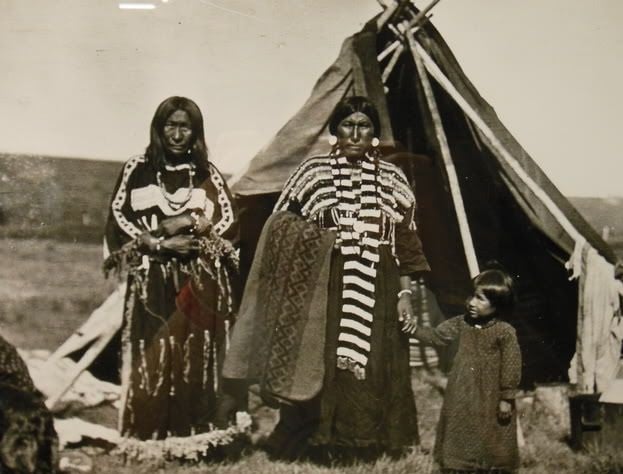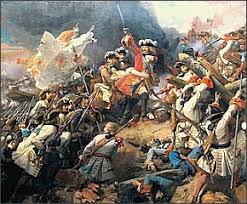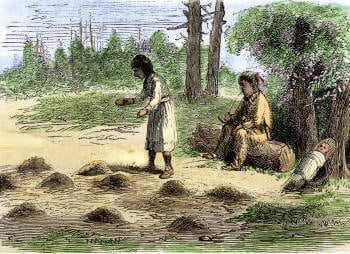Sacred Places in New England
The cultural landscape of American Indians is filled with sacred sites which are described in their oral traditions. There are two basic kinds of sacred sites: (1) those which are sacred because of human acts of consecration, dedication, and ritual practice, and (2) those which are intrinsically holy, places which are endowed with great spiritual power. Very little is known about places which were sacred to the native people of the New England tribes prior to the arrival of the Europeans. What is known comes in part from the fragments of oral tradition which have been recorded, from the early European journals, and from the archaeological record.
Sacrifice Rocks:
The European journals talk about “sacrifice rocks” which held spiritual importance for the Indians. Two of these were on the side of the road between Plymouth and Sandwich in Massachusetts. One of them is described as being six feet high while the other is about four feet high and both are ten to twelve feet in length. The stones were traditionally covered with offerings of wood and stone.
Writing in 1762, Ezra Stiles reports:
“The Indians being asked the reason of their Custom & Practice, say they know nothing about it, only that their Fathers & their Grandfathers & their Great Grandfathers did so, and charged all their Children to do so; and that if they did not cast a Stone or piece of Wood on that Stone as often as they passed by it, they would not prosper, & particularly should not be lucky in hunting deer.”
Mounds of brush and stone were built to mark scenes of tragedy and/or places where warriors were killed. As people passed by these mounds they would add stones and branches to them. There are several thousand of these mounds in New England.
An arrangement of rocks, called hobbomak, was done in an area which was felt to have particularly strong spiritual power. These were places where seekers could obtain spiritual power directly from the spirit world. These appear to have been similar to the vision quest sites in other areas. The hobbomaks, many of which are still known in the area, were considered so powerful that the oral traditions cautioned seekers to use them only under certain ceremonial conditions.
Stone Circles and Chambers:
Part of the sacred Native American landscape in New England is formed with stones: single standing stones, rows of stones, stone circles, and stone chambers. These are often invisible to non-Indians as many are convinced that Indians were not advanced enough to work with stone. With a stereotype of Indians as nomads firmly implanted in their minds by education and the mass media, many non-Indians do not realize that Indians in New England lived in permanent villages and often built their sacred landscape out of stone.

A stone circle at Gungywump in Connecticut is shown above.
We know relatively little today about the use and meaning of specific sites, and we are just beginning to understand that there may be a connection between the various sites. Some of the sites appear to have been observatories, oriented toward solar events (such as the solstices), lunar events (full moons and lunar maximums), and stellar events.
Of particular interest are the Native American chambers in New England. These chambers were built from stone using a corbelling system for the roof. They were often covered with earth and thus, several centuries later, appear to be natural caves. We don’t know what kinds of ceremonies were performed in these, but several have an orientation toward the summer solstice and thus may have had an astronomical function. More than 300 stone chambers have been identified in New England and of these 105 have been determined to have astronomical orientations.
The chamber at Upton, Massachusetts has a passageway about twenty feet long which leads into a circular chamber which is about twelve feet in diameter. Recent renovations at the chamber have shown that no metal tools were used in working the stones. The lintel stone over the entrance was very carefully fitted to the stones on either side.
Another feature in the sacred landscape of New England are the standing stones which often have a shape resembling the upper human torso and head. Some of the standing stones are tall obelisks, others slabs in stone rows that are wider than high. Some of the stones are anthropomorphized stones called god or manitou stones. The standing stones are set upright in the ground or they are supported by other stones. These standing stones are often found near other features, such as stone rows, mounds, and chambers.
Rock Art:
The powwows (spiritual leaders) would often record their visions in pictographic form on rocks. The sites chosen for these pictographs-rocky cliffs, boulders, outcroppings-were places which had sacred significance. These were often places associated with specific spiritual beings and their emergence from either the sky world or the underworld.
Many of the rock art images at Solon, Maine have sexual connotations, including ithyphallic males, sexually receptive females, and images of both male and female genitalia. One of the phalli has wings. Native Americans tended to view sex, sexuality, and nudity as natural and therefore these were not excluded from their spirituality. There are also many non-sexual images, including 15 birds.



